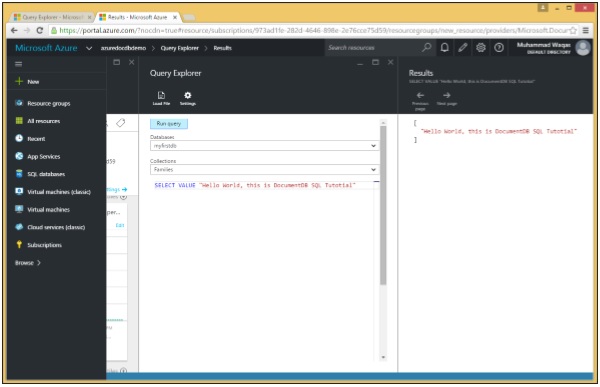documentdb Sql
Khóa học miễn phí DocumentDB SQL – Value Keyword nhận dự án làm có lương
DocumentDB SQL – Value Keyword
When you know you”re only returning a single value, then the VALUE keyword can help produce a leaner result set by avoiding the overhead of creating a full-blown object. The VALUE keyword provides a way to return JSON value.
Let’s take a look at a simple example.

Following is the query with VALUE keyword.
SELECT VALUE "Hello World, this is DocumentDB SQL Tutorial"
When this query is executed, it returns the scalar “Hello World, this is DocumentDB SQL Tutorial”.
[ "Hello World, this is DocumentDB SQL Tutorial" ]
In another example, let’s consider the three documents from the previous examples.
Following is the AndersenFamily document.
{
"id": "AndersenFamily",
"lastName": "Andersen",
"parents": [
{ "firstName": "Thomas", "relationship": "father" },
{ "firstName": "Mary Kay", "relationship": "mother" }
],
"children": [
{
"firstName": "Henriette Thaulow",
"gender": "female",
"grade": 5,
"pets": [ { "givenName": "Fluffy", "type": "Rabbit" } ]
}
],
"location": { "state": "WA", "county": "King", "city": "Seattle" },
"isRegistered": true
}
Following is the SmithFamily document.
{
"id": "SmithFamily",
"parents": [
{ "familyName": "Smith", "givenName": "James" },
{ "familyName": "Curtis", "givenName": "Helen" }
],
"children": [
{
"givenName": "Michelle",
"gender": "female",
"grade": 1
},
{
"givenName": "John",
"gender": "male",
"grade": 7,
"pets": [
{ "givenName": "Tweetie", "type": "Bird" }
]
}
],
"location": {
"state": "NY",
"county": "Queens",
"city": "Forest Hills"
},
"isRegistered": true
}
Following is the WakefieldFamily document.
{
"id": "WakefieldFamily",
"parents": [
{ "familyName": "Wakefield", "givenName": "Robin" },
{ "familyName": "Miller", "givenName": "Ben" }
],
"children": [
{
"familyName": "Merriam",
"givenName": "Jesse",
"gender": "female",
"grade": 6,
"pets": [
{ "givenName": "Charlie Brown", "type": "Dog" },
{ "givenName": "Tiger", "type": "Cat" },
{ "givenName": "Princess", "type": "Cat" }
]
},
{
"familyName": "Miller",
"givenName": "Lisa",
"gender": "female",
"grade": 3,
"pets": [
{ "givenName": "Jake", "type": "Snake" }
]
}
],
"location": { "state": "NY", "county": "Manhattan", "city": "NY" },
"isRegistered": false
}
Following is the query.
SELECT VALUE f.location FROM Families f
When this query is executed, it return the returns the address without the location label.
[
{
"state": "NY",
"county": "Manhattan",
"city": "NY"
},
{
"state": "NY",
"county": "Queens",
"city": "Forest Hills"
},
{
"state": "WA",
"county": "King",
"city": "Seattle"
}
]
If we now specify the same query without VALUE Keyword, then it will return the address with location label. Following is the query.
SELECT f.location FROM Families f
When this query is executed, it produces the following output.
[
{
"location": {
"state": "NY",
"county": "Manhattan",
"city": "NY"
}
},
{
"location": {
"state": "NY",
"county": "Queens",
"city": "Forest Hills"
}
},
{
"location": {
"state": "WA",
"county": "King",
"city": "Seattle"
}
}
]
Khóa học lập trình tại Toidayhoc vừa học vừa làm dự án vừa nhận lương: Khóa học lập trình nhận lương tại trung tâm Toidayhoc
Notice: Trying to access array offset on value of type bool in /home/edua/htdocs/edu.toidayhoc.com/wp-content/themes/flatsome/flatsome/inc/shortcodes/share_follow.php on line 41
